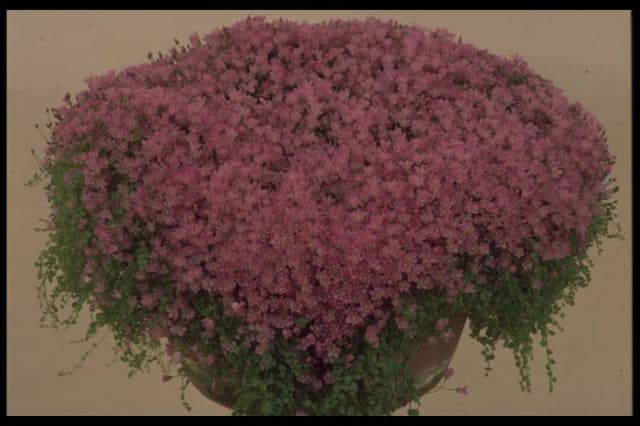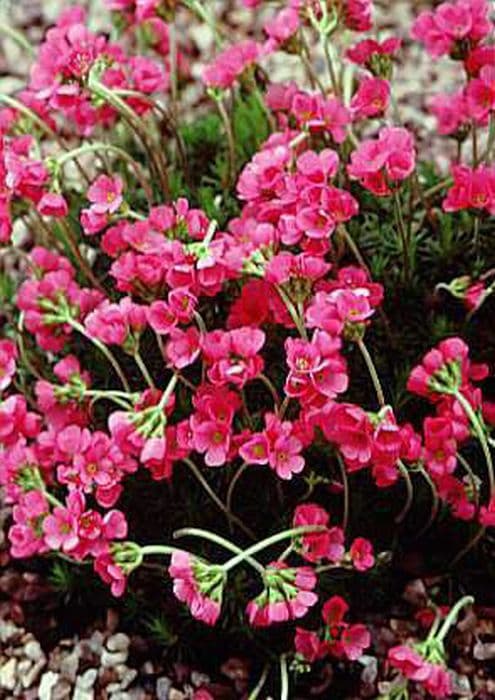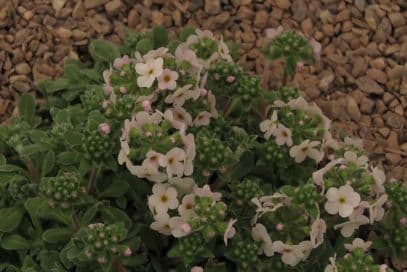Japanese Primrose Primula sieboldii 'Yuhi-beni' (Co)

ABOUT
Primula sieboldii 'Yuhi-beni', often referred to by its common name, Japanese Primrose, presents a stunning display of floral beauty in gardens and natural settings. This variety of Japanese Primrose is particularly captivating due to its blossoms, which exhibit a deeply rich and vivid color palette. The flowers are distinguished by their ruffled edges, contributing to a sense of fullness and dimension within the overall visual presentation. Each blossom showcases varying shades of pink, with some petals having a gradient that fades to a lighter hue or almost white toward the center, creating a striking contrast against the darker pink at the petals' tips. The center of the flower is highlighted by a vibrant, yellowish eye, which serves as an attractive focal point drawing pollinators and the admiration of onlookers alike. The lavish flowers of 'Yuhi-beni' are held aloft on delicate stems, which rise above a lush rosette of green foliage. The leaves are oval to heart-shaped and exhibit a slight ruffle at their edges, mirroring the texture found in the flower petals. The foliage tends to have a dense, ground-covering habit, forming an elegant backdrop that accentuates the floral spectacle above. This textural contrast between the velvety leaves and the intricate blossoms adds to the plant's ornamental charm. Overall, the Japanese Primrose 'Yuhi-beni' is a feast for the eyes, with its mix of refined foliage and flamboyantly colored flowers, making it a prized specimen in any collection of spring-to-summer blooming perennials. Its visual appeal is timeless and is often employed in garden designs that aim for a naturalistic or cottage garden aesthetic. Despite its striking appearance, the 'Yuhi-beni' cultivar maintains a subtle grace, making it a versatile component in various landscaping themes.
About this plant
 Names
NamesSynonyms
Japanese Primrose, Siebold's Primrose, Cherry Blossom Primrose.
Common names
Primula sieboldii 'Yuhi-beni'
 Toxicity
ToxicityTo humans
Primula sieboldii, commonly known as Siebold's primrose, is not considered highly toxic to humans. Generally, this plant is regarded as safe, and there are no well-documented reports of serious toxicity from ingestion. However, some individuals may experience mild discomfort or an allergic reaction if they have sensitivity to Primulaceae family plants. Symptoms can include nausea, vomiting, or diarrhea if ingested in significant amounts. Additionally, contact with the skin can sometimes cause irritation or a rash, particularly in those with sensitive skin or allergies to the plant.
To pets
Siebold's primrose is not known to be highly toxic to pets either. Similar to its effects on humans, this plant may cause mild gastrointestinal upset if ingested by pets such as cats or dogs. Symptoms can include vomiting or diarrhea, although serious cases of poisoning are rare. It is always prudent to monitor your pets around plants and to prevent them from ingesting plant material, especially if they are prone to eating houseplants or garden vegetation.
 Characteristics
CharacteristicsLife cycle
Perennials
Foliage type
Deciduous
Color of leaves
Green
Flower color
Pink
Height
6 inches (15 cm)
Spread
8 inches (20 cm)
Plant type
Herb
Hardiness zones
5
Native area
Japan
Benefits
 General Benefits
General Benefits- Aesthetic Appeal: The Primula sieboldii 'Yuhi-beni', commonly known as Siebold's Primrose, offers vibrant pink flowers that enhance the visual appeal of gardens and landscapes.
- Pollinator Attraction: Siebold's Primrose attracts bees, butterflies, and other beneficial insects, which are essential for pollination in the garden ecosystem.
- Low Maintenance: This plant is relatively easy to care for, requiring minimal maintenance once established, making it suitable for both novice and experienced gardeners.
- Tolerates Different Light Conditions: Siebold's Primrose can thrive in a range of light conditions, from full sun to partial shade, providing flexibility in garden design.
- Spring Bloomer: As an early spring bloomer, it contributes to the succession of blooms in a garden, bringing color and life after the winter season.
- Cool Climate Adaptability: Siebold's Primrose is well-suited for cooler climates, making it a great addition to gardens in temperate regions.
- Versatility in Landscaping: This primrose can be used in a variety of gardening styles, such as rock gardens, borders, or as ground cover under deciduous trees.
- Non-Invasiveness: Siebold's Primrose does not aggressively spread, reducing the risk of overtaking other plantings in the garden.
 Medical Properties
Medical PropertiesThis plant is not used for medical purposes.
 Air-purifying Qualities
Air-purifying QualitiesThis plant is not specifically known for air purifying qualities.
 Other Uses
Other Uses- Art and Illustration: The vivid colors of Primula sieboldii 'Yuhi-beni', commonly known as Japanese Primrose, can be used as inspiration for artists and illustrators, especially for botanical art.
- Culinary Garnish: The edible flowers of Japanese Primrose can be used to add color and a mild flavor to salads and desserts.
- Fabric Dyeing: Petals of Japanese Primrose may be used in natural dyeing processes to impart colors to fabrics, although this is not a common use.
- Photography: Japanese Primrose is a popular subject for photographers due to its striking beauty, particularly during its blooming season.
- Educational Tool: Botany educators can use this plant to teach students about plant biology, pollination, and horticulture practices.
- Landscape Design: Garden designers can use Japanese Primrose as part of a planting scheme to create contrast with its vivid bloom against green foliage.
- Feng Shui: According to Feng Shui practices, placing Japanese Primroses in certain areas of a garden can bring about positive energy and enhance the space's aesthetics.
- Crafting: The flowers of Japanese Primrose can be used in dried flower arrangements or as natural confetti for eco-friendly celebrations.
- Special Events: The plant can be featured in ceremonies and cultural festivals in Japan, including hanami, which is the tradition of enjoying the beauty of flowers.
- Ice Cubes: The blossoms can be frozen into ice cubes to add an ornamental touch to cold beverages, particularly in high-end restaurants or at special events.
Interesting Facts
 Feng Shui
Feng ShuiThe Japanese Primrose is not used in Feng Shui practice.
 Zodiac Sign Compitability
Zodiac Sign CompitabilityThe Japanese Primrose is not used in astrology practice.
 Plant Symbolism
Plant Symbolism- Perennial New Beginnings: As a perennial, Primula sieboldii represents recurring life and rejuvenation, symbolizing new beginnings and cycles of life.
- Vitality and Adaptability: Known for its resilience and ability to thrive in various conditions, this plant symbolizes vitality and the ability to adapt to life's changing circumstances.
- Innocence and Delicacy: 'Yuhi-beni', with its delicate blossoms, is often associated with innocence, gentleness, and fragility, reflecting the fleeting nature of life's beautiful moments.
- First Love and Young Romance: Given its early bloom in spring, Primula is linked to first love and young romance, representing the fresh and exciting beginnings of a romantic relationship.
- Hope and Comfort: The bright blooms of this plant in early spring bring hope and are a comforting sign that winter is ending, symbolizing the promise and anticipation of warmer days.
 Water
WaterJapanese Primrose prefers consistently moist soil, so it should be watered thoroughly whenever the top inch of soil feels dry to the touch. Aim to water this plant every few days, depending on the temperature and humidity in your area, which could increase or decrease the watering frequency. Use lukewarm water and gently water at the base to avoid wetting the foliage, as this can lead to fungal diseases. An approximate guideline is to provide about 16-24 ounces of water per week, adjusting as necessary for environmental conditions.
 Light
LightJapanese Primrose thrives in light shade to partial sunlight. Place the plant in a spot where it can receive bright, indirect light for the best growth. Avoid exposing it to the harsh afternoon sun, especially in hotter climates, as it may scorch the leaves and stress the plant.
 Temperature
TemperatureJapanese Primrose does best in cool to moderate temperatures, ideally between 60°F and 75°F. They can tolerate temperatures as low as 50°F, but avoid letting them experience prolonged periods of temperatures below this range. On the warmer side, ensure that they aren't exposed to temperatures above 80°F for extended periods.
 Pruning
PruningJapanese Primrose benefits from pruning to remove spent flowers and encourage further blooming. Deadhead the flowers after they fade, and trim back any dead or yellowing leaves to maintain a tidy appearance. The best time for more extensive pruning is after the blooming period, at the end of spring or early summer, to prepare the plant for the next growing season.
 Cleaning
CleaningAs needed
 Soil
SoilJapanese Primrose ‘Yuhi-beni’ thrives in well-draining, humus-rich soil with a slightly acidic to neutral pH of 6.0-7.0. A mix containing peat, loam, and coarse sand or perlite is ideal.
 Repotting
RepottingJapanese Primrose ‘Yuhi-beni’ should be repotted every 1-2 years, preferably in the spring after flowering or in the fall.
 Humidity & Misting
Humidity & MistingJapanese Primrose ‘Yuhi-beni’ prefers to grow in moderate to high humidity conditions, ideally around 50-70%.
 Suitable locations
Suitable locationsIndoor
Provide bright, indirect light; maintain moist soil and high humidity.
Outdoor
Plant in partial shade; protect from harsh sun and heavy frost.
Hardiness zone
4-8 USDA
 Life cycle
Life cycleThe Japanese primrose 'Yuhi-beni' starts its life cycle as a seed, typically requiring a period of cold stratification to break its dormancy and germinate. Upon germination, it develops into a small seedling with a rosette of leaves at ground level, and as it matures, it forms a robust clump of foliage. Each spring, the plant sends up flowering stems that bear clusters of vibrant, pink-hued flowers, attracting pollinators to aid in reproduction. After pollination, the flowers develop into capsules containing numerous tiny seeds. The plant then enters a period of senescence, where above-ground foliage dies back, but the root system remains alive. Throughout the winter, the plant rests in a dormant phase until the following spring when new growth emerges from the surviving roots, completing its perennial life cycle.
 Propogation
PropogationPropogation time
Spring to early summer
Primula sieboldii 'Yuhi-beni', commonly known as Japanese Primrose, is most effectively propagated through division, which is usually done in late summer or early fall after the flowering season has ended. To propagate by division, carefully lift the plant from the ground using a spade or garden fork, ensuring you keep a good amount of soil around the roots. Gently tease apart the clump into smaller sections, making sure each new section has a portion of the roots and a few growing points or leaves. These divisions can then be replanted in moist, well-draining soil, spacing them approximately 6 to 12 inches (15 to 30 centimeters) apart to allow room for growth. Water thoroughly after planting to help establish the new divisions. This method allows for the plants to recover during the cooler months, providing a strong start for the next growing season.









